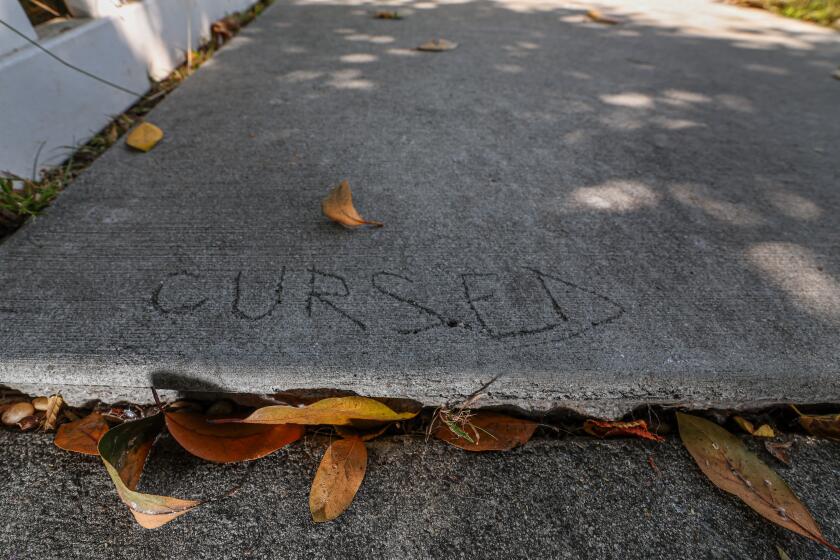How L.A. can fix our scary sidewalks for the Olympics

- Share via
Los Angeles’ broken sidewalks are like an obstacle course, especially for people with disabilities. They are bad enough to challenge the Olympic athletes who will show up in four years.
In 2016, to settle an Americans With Disabilities Act lawsuit, Los Angeles committed to spending $1.4 billion over 30 years to make its sidewalks accessible. But a 2021 audit by the Los Angeles Controller’s Office revealed that since 2016, the city had repaired less than 1% of sidewalks. During that period, the city paid more than $35 million in settlements related to sidewalk injuries.
Under California law, property owners are responsible for maintaining the adjacent sidewalks. Nevertheless, Los Angeles agreed to use general fund revenue — from taxpayers — to repair the sidewalks. Why is the city spreading the burden of sidewalk maintenance to all residents, including the 63% of Los Angeles households that rent rather than own their homes? And how do we speed up progress on the repairs?
Your sidewalk needs to be fixed, so what do you do? Leave town? Get yourself a sturdy burro? Or try to work with the city of Los Angeles? Good luck on all fronts
Requiring property owners to repair damaged sidewalks that Los Angeles has ignored for decades would cost too much for many Angelenos who don’t have the cash. Fortunately, there is a fair and efficient way to solve the property owners’ cash-flow problems: pay-on-exit.
In the pay-on-exit system, owners can defer paying for sidewalk repairs until they sell their property. Everyone can pay some or all of the cost before the sale, but any remaining debt, plus interest, would be due at sale when the owner is flush with cash (according to Redfin, in July 2024 the median sale price of single-family homes in Los Angeles was $1.1 million).
The pay-on-exit model isn’t new. For example, California allows low-income senior citizens to defer property taxes until they sell their homes or die, with an annual interest rate of 5% for the deferred amount.
Banks, not the city, would lend money to the property owners and earn interest on the loans. The property owners would pay for the repairs, and banks would allow them to defer payments until the properties are sold. Banks can finance the loans for sidewalk repairs like second mortgages that are repaid, with interest, in the escrow process at sale.
Lost in the debate over fixing L.A.’s sidewalks is the fact that the city planted street trees much better suited for wide-open parks.
L.A.’s only costs would be for inspecting sidewalks, citing the broken ones and supervising the needed repairs to ensure compliance with city requirements, though it could also subsidize deferred sidewalk debts for low-income property owners. The banks could proudly market the loans for repairs as their contribution to bringing sidewalks in Los Angeles up to ADA standards before the 2028 Olympics (with gold medals for everyone involved).
With financing in place, the city could solicit bids for the sidewalk repairs from Southern California’s many contractors. Working simultaneously, they should be able to complete the task well before the Olympics. The repairs would make sidewalks accessible, prevent countless injuries, boost the economy and save the city millions of dollars every year in paying to settle injury lawsuits.
Even property owners with a broken sidewalk would get a good deal. In exchange for repairing one patch of broken sidewalk, the owners can expect better sidewalks everywhere.
In addition, property owners would benefit from the increased curb appeal of their homes. If potential buyers stumble over a broken sidewalk in front of a house for sale, they might decide to look elsewhere. To further improve curb appeal, Los Angeles could plant shade trees in the parkways alongside the repaired sidewalks — but only ones that won’t damage the sidewalk.
The U.S. can once again lead the disability rights movement.
Property ownership has responsibilities as well as rights. Using pay-on-exit finance to fix broken sidewalks can put Johann Wolfgang von Goethe’s adage into practice: “Let everyone sweep in front of their own door, and the whole world will be clean.”
Expensive houses with broken sidewalks are a stark example of private affluence and public squalor. A pay-on-exit program is the fairest and most practical way out of this dilemma. Only property owners with damaged sidewalks would pay anything, they can do so out of sale proceeds and everyone will live in a better city.
Accessible sidewalks and a more walkable Los Angeles would be a splendid legacy of the 2028 Olympics. Beyond that astonishing achievement, the city could support pay-on-exit finance as a promising way to fund local public investments worldwide. Why not start now?
Donald Shoup is a distinguished research professor in urban planning at UCLA.
More to Read
A cure for the common opinion
Get thought-provoking perspectives with our weekly newsletter.
You may occasionally receive promotional content from the Los Angeles Times.












